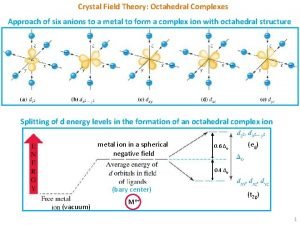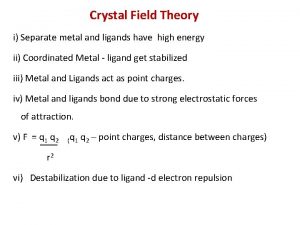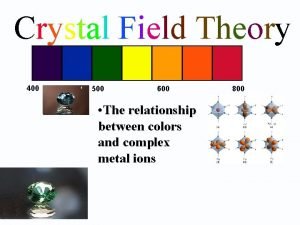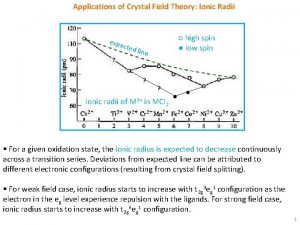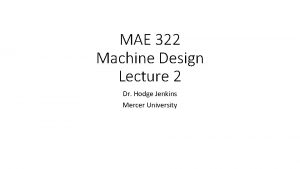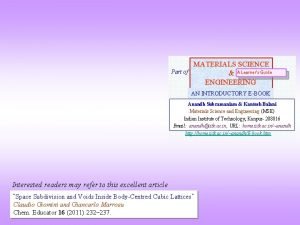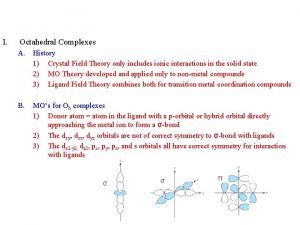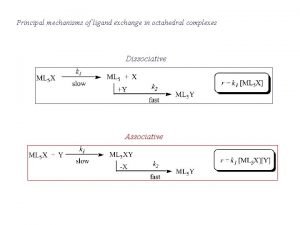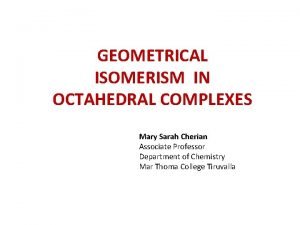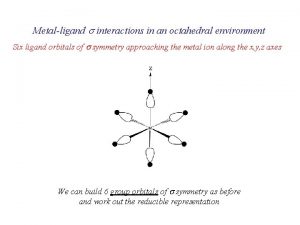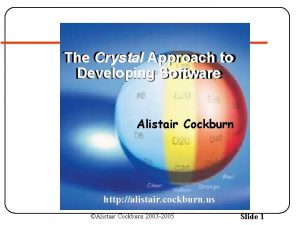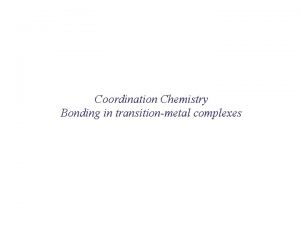Crystal Field Theory Octahedral Complexes Approach of six









- Slides: 9

Crystal Field Theory: Octahedral Complexes Approach of six anions to a metal to form a complex ion with octahedral structure Splitting of d energy levels in the formation of an octahedral complex ion metal ion in a spherical negative field 0. 6 Δo (eg) 0. 4 Δo (bary center) (vacuum) Mn+ (t 2 g) 1

Factors that Affect Crystal Field Splitting 1) Nature of the ligand: Spectrochemical Series increasing Δo weak field ligands strong field ligands § Ligands with the same donor atoms are close together in the series. § Ligands up to H 2 O are weak-field ligands and tend to result in high-spin complexes. § Ligands beyond H 2 O are strong-field ligands and tend to result in low-spin complexes. § CFT can not explain why certain anionic ligands lies lower in the series than neutral ligands, although reverse should be expected based on electrostatic interactions. § It also can not explain why OH- lies lower in the series than H 2 O and NH 3, although reverse should be expected, since dipole moment of OH- is greater than H 2 O and NH 3. 2

Factors that Affect Crystal Field Splitting Nature of Ligand Complex Δo (cm-1) [Cr. Cl 6]3 - 13640 [Cr(H 2 O)6]3+ 17830 [Cr(NH 3)6]3+ 21680 [Cr(CN)6]3 - 26280 Nature of Metal Ion Oxidation State of Metal Ion Complex Δo (cm-1) [Fe(H 2 O)6]2+ 9400 Complex Δo (cm-1) [Fe(H 2 O)6]3+ 13700 [Co(NH 3)6]3+ 24800 [Co(H 2 O)6]2+ 9300 [Rh(NH 3)6]3+ 34000 [Co(H 2 O)6]3+ 18200 [Ir(NH 3)6]3+ 41000 3

Factors that Affect Crystal Field Splitting Mn 2+< Ni 2+ < Co 2+ < Fe 2+ < V 2+ < Fe 3+ < Co 3+ < Mn 4+ < Mo 3+ < Rh 3+ < Ru 3+ < Pd 4+ < Ir 3+ < Pt 4+ increasing Δo ▪ This trend is independent of ligand. 2) Oxidation State of Metal Ion: Δo increases with increasing oxidation number of the metal. This is due to the smaller size of the more highly charged ion, resulting in smaller metal to ligand distances and hence, a greater ligand field. 3) Nature of Metal Ion: Within any periodic group, Δo increases down a group (3 d < 4 d < 5 d). This is due to the larger size of the 4 d or 5 d orbitals compared with the compact 3 d orbitals and the consequent stronger interactions with the ligands. ▪ For a given ligand a given oxidation state, Δo varies irregularly across the first row transition metal elements. Complex Δo (cm-1) [Cr(H 2 O)6]3+ 17400 [Fe(H 2 O)6]3+ 14000 [Co(H 2 O)6]3+ 20760 4

Crystal Field Stabilization Energy: High & Low Spin Octahedral Complexes § CFSE: Difference in energy between the d electrons in an octahedral crystal field and the d electrons in a spherical crystal field (isotopic field). § CFSE for (t 2 g)x(eg)y configuration = (0. 4 x - 0. 6 y)Δo (ignoring pairing energy) § For d 4 configuration, the size of the gap (Δo) will determine whether the fourth electron enters the lower t 2 g set of orbitals, or the upper eg set of orbitals. The outcome will depend on the relative size of the splitting versus the pairing energy. § Weak Field Case: When the gap is relatively small, the extra electron occupies the upper set of orbitals, rather than pair up with an electron in lower set. § Strong Field Case: When the size of Δo is substantial, and the gap is too great compared to the pairing energy, the electron pairs up in the lower t 2 g set. 5

Crystal Field Stabilization Energy: High & Low Spin Octahedral Complexes § CFSE for d 4 weak field case = [3 × 0. 4 Δo – 1 × 0. 6 Δo] = 0. 6 Δo § CFSE for d 4 strong field case = 4 × 0. 4 Δo = 1. 6 Δo § The different electron configurations are referred to as high spin (for the weak field case) and low spin (for the strong field case). § The possibility of high and low spin complexes exists for configurations d 5 -d 7 as well. 6

Crystal Field Stabilization Energy: High & Low Spin Octahedral Complexes § Electron-pairing energy (P): Energy required to change two electrons with parallel spin in different degenerate orbitals into spin-paired electrons in the same orbital. § Two terms contribute to pairing energy: a) loss in the exchange energy which occurs upon pairing the electrons. b) Coulombic repulsion between the spin-paired electrons. § CFSE for (t 2 g)x(eg)y configuration = (0. 4 x - 0. 6 y)Δo - p. P (considering pairing energy) p = total number of electron pairs compared to corresponding high-spin configuration; P = mean pairing energy Free Ion CFSE High Spin Low Spin d 4 0. 6Δo 1. 6Δo - P d 5 0Δo 2. 0Δo - 2 P d 6 0. 4Δo 2. 4Δo - 2 P d 7 0. 8Δo 1. 8Δo - P 7

Crystal Field Theory: Tetrahedral Complexes Δt = 4/9 Δo = 0. 44 Δo (t 2) (e) § Imagine a tetrahedral molecule inside a cube with metal ions in the center of the cube. The ligands occupy the four alternate corners of the cube leaving the rest four corners empty. § The two ‘e’ (dx 2 -y 2 and dz 2) orbitals point to the center of the face of the cube while three ‘t 2’ (dxy, dyz and dzx) orbitals point to the center of the edges of the cube. § Thus, the t 2 orbitals are nearer to the direction of approach of the ligands than the e orbitals. (The ligands do not directly approach any of the metal d orbitals) 8

Crystal Field Theory: Tetrahedral Complexes § Why almost all tetrahedral complexes are high spin? § There are only 4 ligands in the tetrahedral complex and hence the ligand field is roughly 2/3 of the octahedral field. § The direction of ligand approach in tetrahedral complex does not coincide with the d -orbitals. This reduces the field by a factor of 2/3. Therefore Δt is roughly 2/3 x 2/3 = 4/9 of Δo. § As a result, all tetrahedral complexes are high-spin since the Δt is normally smaller than the paring energy. Hence, low spin configurations are rarely observed. Usually, if a very strong field ligand is present, square planar geometry will be favored. § When do we expect tetrahedral geometry? § Small metal ions and large ligands (Cl-, Br- and I-) because then ligand-ligand repulsions cancel the energy advantage of forming more metal-ligand bonds. § Metal ions with zero CFSE (d 0, d 5, d 10) or small CFSE (d 2 and d 7). § Examples: Mn. O 4 - (d 0), Fe. Cl 4 - (d 5, h. s. ), Co. Cl 42 - (d 7, h. s. ), Zn. Cl 42 - (d 10) 9
 Splitting in octahedral complexes
Splitting in octahedral complexes Ligand isomerism
Ligand isomerism Miller indices of diagonal plane of cube
Miller indices of diagonal plane of cube Splitting orbital
Splitting orbital Trigonal bipyramidal crystal field splitting diagram
Trigonal bipyramidal crystal field splitting diagram What are the salient features of crystal field theory
What are the salient features of crystal field theory Applications of crystal field theory
Applications of crystal field theory Octahedral stress theory
Octahedral stress theory Bond angles and shapes
Bond angles and shapes Octahedral voids in bcc
Octahedral voids in bcc
